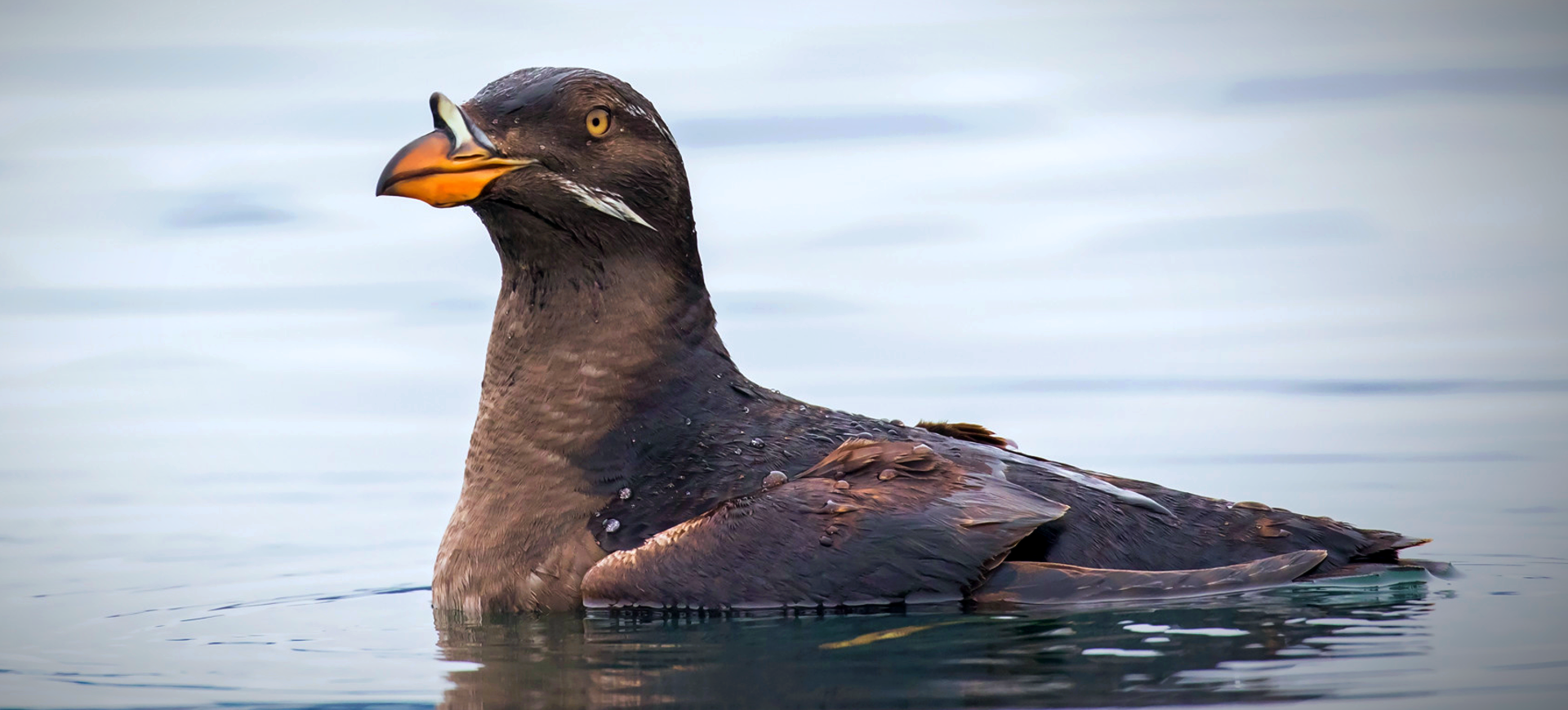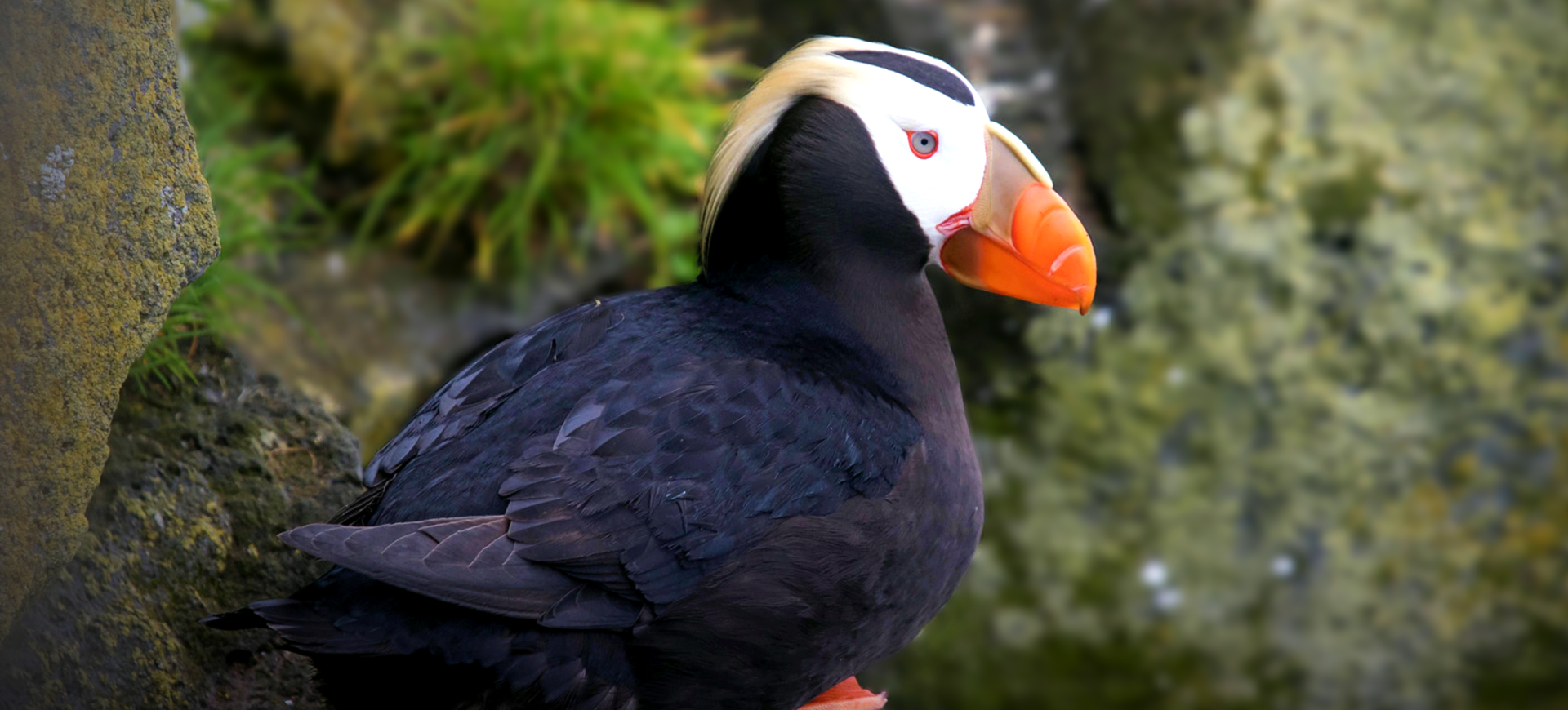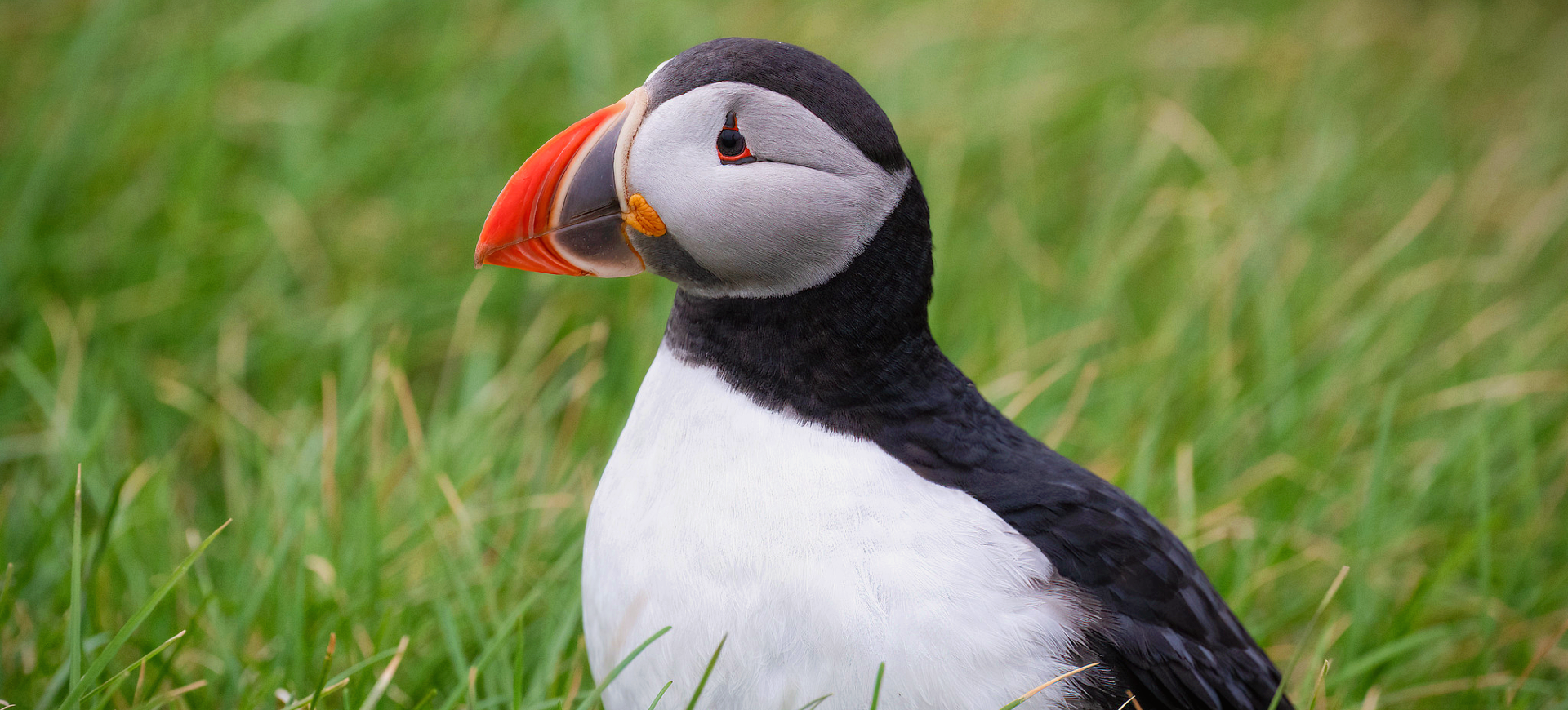Overview
The Horned Puffin, named for the small, fleshy “horn” above its eyes, is a distinctive seabird found in the North Pacific Ocean. Characterized by its striking black and white plumage and large, brightly colored bill, the Horned Puffin resembles its Atlantic cousin but with notable differences, including the horn-like projections from which it gets its name. These birds breed on rocky cliffs and islands, laying their eggs in crevices or burrows. Outside the breeding season, Horned Puffins lead an aquatic life, spending months at sea where they are well adapted to a diet of fish and marine invertebrates.
Horned Puffins are remarkable divers, using their wings to propel themselves underwater in pursuit of prey. Their diet consists mainly of small fish, squid, and crustaceans, which they catch with precision. During the breeding season, their bills and feet turn vibrant orange, adding to their distinctive appearance. These seabirds are known for their loyalty to their nesting sites, returning to the same location year after year to mate and raise their single chick.
The conservation status of the Horned Puffin is of increasing concern due to threats such as climate change, overfishing, and pollution, which impact their food sources and breeding habitats. Despite these challenges, Horned Puffins fascinate birdwatchers and wildlife enthusiasts with their unique appearance and behaviors. Their ability to navigate vast oceanic expanses and their specialized feeding techniques highlight the adaptability of seabirds to the marine environment.
Taxonomy
Kingdom
Phylum
Class
Order
Family
Genus
Species
Type
Physical Description:
Horned Puffins are medium-sized birds, easily recognizable by their black backs, white bellies, and the striking black-and-white coloring of their faces. The most distinctive feature, however, is the large, brightly colored bill and the small, horn-like projections above their eyes, which are more prominent in males. These features become more pronounced and colorful during the breeding season, serving as important visual signals for attracting mates. The waterproof plumage of the Horned Puffin is perfectly adapted for its aquatic lifestyle, providing insulation and buoyancy.
Adult Horned Puffins typically measure about 14 inches long, with a wingspan of approximately 23 inches. Despite their somewhat clumsy appearance on land, they are agile fliers and excellent swimmers. The morphology of their wings allows for efficient propulsion both in the air and underwater, where they pursue their prey. Their feet, positioned towards the back of their body, act as rudders, precisely steering them through the water.

Lifespan: Wild: ~20 Years || Captivity: ~25 Years

Weight: Male & Female: 1.1-1.4 lbs (500-650 g)

Length: Male & Female: 12-14 inches (30-36 cm)

Height: Male & Female: 8-14 inches (20-36 cm)

Wingspan: Male & Female: 22-25 inches (56-64 cm)

Top Speed: 55 mph (88 km/h)
Characteristic:
Native Habitat:
Horned Puffins are native to the cold, nutrient-rich waters of the North Pacific Ocean. Their breeding grounds are located on rocky islands and cliffs across a broad geographical range, from the coasts of Alaska and Siberia to British Columbia. These locations provide the necessary seclusion and protection from predators, making them ideal for nesting. Horned Puffins are well adapted to their marine environment, with physiological and behavioral adaptations that enable them to thrive both at sea and in their nesting habitats.
Outside the breeding season, Horned Puffins lead an aquatic existence, spending months on the open ocean. This lifestyle demands a high degree of adaptability, as conditions in the marine environment can be highly variable and challenging. The vast range of their habitat encompasses diverse ecosystems, from the Bering Sea’s icy waters to the temperate regions of the North Pacific, demonstrating the Horned Puffin’s remarkable versatility.
Climate Zones:
Biogeographical Realms:
Continents:
Countries:
Diet:
Diet & Feeding Habits:
Horned Puffins are adept hunters, primarily feeding on small fish, squid, and crustaceans. They utilize their excellent diving capabilities to pursue prey underwater, propelling themselves with swift wing movements. These seabirds can dive to significant depths, often exceeding 100 feet, to find food. Their diet varies with availability, season, and location, reflecting the rich biodiversity of the North Pacific marine ecosystem.
During the breeding season, Horned Puffins face the added challenge of feeding their chick, which requires frequent trips back and forth between the sea and their nesting sites. The efficiency of their hunting is crucial during this period, as it directly impacts the survival and health of their offspring. Environmental changes affecting the abundance and distribution of their prey can significantly influence their breeding success and population health.
Mating Behavior:
Mating Description:
Horned Puffins are monogamous, often forming long-term pair bonds for several breeding seasons. They exhibit fidelity to their nesting sites, returning to the same location year after year to breed. The breeding season begins in late spring or early summer when Horned Puffins gather in colonies on rocky cliffs and islands. Here, they engage in courtship displays, which include bill rubbing and vocalizations, to strengthen pair bonds and establish nesting territories.
The female lays a single egg in a crevice or burrow, which both parents then incubate. After hatching, the chick depends on its parents for food, receiving a regurgitated fish and invertebrates diet. The chick’s growth is rapid; within six weeks, it is ready to fledge and venture into the ocean. The success of the breeding season is closely tied to food availability, highlighting the importance of healthy marine ecosystems for the survival of Horned Puffin populations.
Reproduction Season:
Birth Type:
Pregnancy Duration:
Female Name:
Male Name:
Baby Name:
Social Structure Description:
During the breeding season, Horned Puffins form dense colonies on rocky islands and cliffs, where social interactions are crucial in mating and nesting behaviors. These colonies provide a safe environment for raising chicks, with parents often cooperating to defend against predators. Outside the breeding season, Horned Puffins are more solitary, spending their time at sea searching for food.
The social dynamics within puffin colonies, including the establishment of nesting territories and pair bonding, are essential for the success of the breeding season. The ability of Horned Puffins to form long-term pair bonds and exhibit fidelity to their nesting sites is a key aspect of their social structure, contributing to their resilience in the face of environmental challenges.
Groups:
Conservation Status:
Population Trend:
The global population of Horned Puffins is not well documented, making it difficult to assess trends with precision. However, localized studies suggest that populations in certain areas are stable, while others may be experiencing declines due to environmental pressures. The primary concerns for Horned Puffin populations include climate change, which affects sea temperatures and prey availability, and human activities, such as overfishing and pollution, which can impact their food sources and breeding habitats.
Conservation efforts for Horned Puffins focus on protecting their breeding grounds from disturbance and pollution and ensuring sustainable practices in fisheries to maintain healthy fish populations. The adaptability of Horned Puffins to a range of marine environments offers some resilience, but ongoing monitoring and conservation actions are essential to address the challenges they face.
Population Threats:
Horned Puffins face several threats that can impact their survival, including climate change, overfishing, and pollution. Climate change, in particular, poses a significant risk by altering the marine ecosystems on which these birds rely for food and nesting sites. Overfishing can deplete the small fish populations crucial to the puffin diet, while pollution, especially oil spills, can devastate seabird populations.
Other threats include predation by introduced species on nesting islands and human disturbance of breeding colonies. Addressing these challenges requires a comprehensive approach to marine conservation, including protected areas, sustainable fisheries management, and efforts to mitigate climate change impacts on marine ecosystems.
Conservation Efforts:
Conservation initiatives for Horned Puffins include habitat protection, research, and monitoring programs to understand their ecology and population dynamics. Protected areas and marine sanctuaries safeguard breeding sites and foraging grounds. Efforts to reduce pollution and manage fisheries sustainably are also crucial for conserving Horned Puffin populations.
Education and outreach programs can help raise awareness about the importance of marine conservation and the threats faced by seabirds. International cooperation is essential for addressing the challenges of climate change and ensuring the health of the North Pacific ecosystems that support Horned Puffin populations.
Additional Resources:
Fun Facts
- Horned Puffins can hold several fish in their bills at once, thanks to a unique structure that allows them to catch new prey without losing the ones already caught.
- They can dive to depths of over 100 feet to find food.
- The “horn” above the eyes of the Horned Puffin is a small, fleshy projection that becomes more pronounced during the breeding season.
- Horned Puffins use their wings to “fly” underwater, reaching impressive speeds as they chase after fish.
- They spend most of their lives at sea, only coming ashore to breed.
- The colorful bill of the Horned Puffin fades to a duller color outside the breeding season.
- These birds are skilled fliers, capable of reaching speeds up to 55 mph.
- The breeding success of Horned Puffins is highly dependent on the availability of suitable nesting sites and abundant food sources.
- Horned Puffins are part of the Alcidae family, which includes other auks, murres, and guillemots.
- Horned Puffins are exceptionally agile in the water despite their awkward appearance on land.









